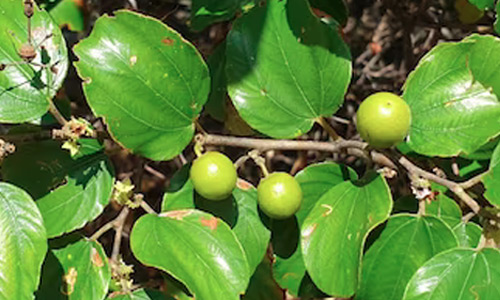|
Division
|
Angiosperms |
|
Class
|
Dicotledons |
|
Subclass |
Polypetalae |
|
Series |
Disciflorae |
|
Order |
Celastrales |
|
Family
|
Rhamnaceae |
|
Genus
|
Ziziphus (Zizyphus) |
|
Species
|
mauritiana |

|
Etymology:
|
Derived from Greek word Ziziphus, name of the Mediterranean jujube which is derived from Arabic zizout, name of the lotus. |
|
Botanical name:
|
Ziziphus mauritiana Lam. (Zizyphus jujuba Lam.) |
|
Local/Trade Names: |
Indian Jujube, Common Jujube, Ber |
|
Conservation status:
|
Commonly found wild. |
|
Digonestic features:
|
A prickly tree. |
|
Description: |
A moderate sized tree. Bark dark grey or nearly black, young parts rusty tomentose. Leaves very variable, 2.5-10 cm long, sub-orbicular, elliptic or ovate, serrulate or entire, densely woolly-tomentose beneath. Flowers greenish-yellow. Fruit a drupes, 2-celled, 1.5 cm long, globose to ellipsoid or obovoid-acuminate, red or orange when ripe. |
|
Phenology: |
Fls.: Sept.-Nov. Frts.: Dec.-Feb. |
|
Distribution:
|
Throughout the India. |
|
Where to see it: |
Medicinal Plant Garden, Nutritive Garden and Gate No. 2 side. |
|
Uses: |
Fruits eaten fresh, dried like raisins, candied, stewed or smoked. Tree also yields fodder and is grown for wind-breaks. Large-sized fruits, which have just began to turn yellow are chosen for candying. Fruits of wild trees considered cooling, anodyne, and tonic. They enter into the preparation of Joshanda, a medicine used in chest troubles. Kernels sedative, used as a soporific and to stop vomiting; also employed as an antidote to aconite-poisoning and for abdominal pain in pregnancy. Seeds are given in diarrhoea. Badari is mentioned in old literature in the list of contracptives. Seeds yield a fatty oil. Leaves eaten with catechu as an astringent; considered diaphoretic. Wood used for wells, axe-and hoe-handles, gun-stocks, sandals, yokes, toys, parts of wheels, and turnery. |
Chief Conservator of Forests & Chief Wildlife Warden is the Head of the Department. There is one post of Conservator of Forests & two posts of Deputy Conservator of Forests viz.